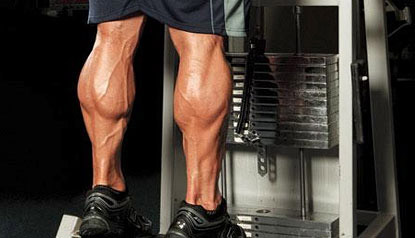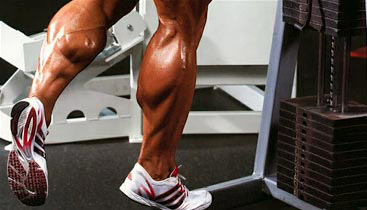CALF TRAINING FOR MASS: 4 TIPS TO BUILD SKINNY CALVES

There’s no question that building up naturally skinny calves can be quite a challenge for many trainees.
Aside from a couple of legitimate genetic disadvantages at play(Check out my previous post, “Why Calves Don’t Grow Easily” for a brief explanation of this), most guys also make several simple but crucial errors in their training form that make adding significant size to their calves next to impossible.
In this article I’m going to outline 4 very important tips that you should be applying to all of your standing calf raise movements (the #1 movement I recommend for optimal calf training) if you want to see the very best results possible.
Give these a try on your next workout and I guarantee you’ll notice a significant difference in how effectively you’re able to stimulate your calves…
Calf Training For Mass: Form Tip #1
Instead of driving yourself up onto the entire ball of your front foot, focus on raising yourself up onto your big toe instead.
This prevents your feet and ankles from rolling outward and maximally stimulates the inner portion of your calf where the largest percentage of the mass is located.
If you simply perform a regular calf raise without thinking about this, your body will naturally follow the path of least resistance and do the opposite, since your big toe is positioned furthest away.
Give this one a try and you should notice an immediate improvement in how intensely you’re able to contract your calves on each rep.
Calf Training For Mass: Form Tip #2
When most people perform standing calf raises, they place their feet at shoulder width apart or narrower throughout the exercise.
While this will certainly still work when it comes to stimulating the calves for growth, an even better approach is to go slightly wider at an inch or two outside of shoulder width.
Just like pressing yourself up onto your big toe, using a wider stance on your calf raises prevents your ankles from rolling outward as you press yourself up.
If you want to mix in some sets with a narrower stance that’s fine, but use the wider stance as the foundation of your calf training.
Calf Training For Mass: Form Tip #3
One very common and detrimental calf training mistake is in the excessive use of momentum.
In fact, it’s rare to see a lifter at the gym who doesn’t perform their calf raises in this way. The majority of people simply load up the weights and then “bounce” their way through the set by pumping out their reps without any real pause at the top or bottom of the movement.
When you “bounce” yourself out of the bottom position of a calf raise, you greatly minimize the amount of tension that is placed on the actual calf muscles and redirect it towards your achilles tendon instead.
The achilles tendon is an elastic tissue that connects the calves to the bottom of the foot. When you lower the resistance quickly, the achilles tendon gets loaded on the way down, and when you bounce out of the bottom position, you’re primarily using the elastic energy return potential of the tendon to raise yourself back up. As a result, a much smaller amount of actual muscular work ends up being involved.
The solution? Slow down your reps and stop using momentum.
Here’s what I’d recommend…
Pause in the very bottom position for a full 2 seconds… press yourself up as hard and fast as you can in proper form… pause in the fully contracted position for 1 second… and then lower yourself in 3-4 seconds.
This particular cadence will maximize the stress on your calves and minimize the involvement of the achilles tendon.
Calf Training For Mass: Form Tip #4
Keeping a very slight bend in your knees during standing calf raises is a good idea since it will take some of the stress off of your knee joints, however, the bend should be exactly that: very slight.
Bend your knees too much and you’ll be greatly reducing the effectiveness of your calf training by de-activating the gastrocnemius (the head of the calf where the vast majority of the muscle is located) and shifting the emphasis onto the much smaller and less significant soleus muscle that runs underneath.
Make sure to bend your knees just enough so that they aren’t completely locked out, but no further.
4 Tips For Building Skinny Calves: Quick Review

So, just to quickly recap the standing calf raise form tips we covered here…
1) As you press up, focus on raising yourself up onto your big toe rather than the entire front of your foot.
2) Stand with your feet positioned 1-2 inches outside of shoulder width.
3) Use the following rep cadence for the best results: press yourself up as hard and fast as you can in proper form… pause in the top position for 1 full second… lower yourself in 3-4 seconds… and pause in the bottom position for 2 seconds.
4) Keep only a very slight bend in your knees to take pressure off of your knee joints, but no further than this.
For a rundown of my top 5 recommended calf exercises along with some effective sample calf workouts, check out this previous post.
If you found this article helpful, make sure to sign up for your FREE custom fitness plan below...




